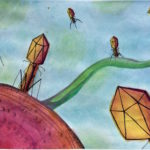Biosciences researchers are among the recipients of four new DOE awards. Two awards will focus on reducing carbon emissions while producing bioenergy. The other two are aimed at understanding the role of microbiomes in the biogeochemical cycling of elements like carbon.
Exploring the Genetics and Mechanisms of ‘Bacterial Homing Missiles’
A team at the Berkeley Lab explored the genetic basis and physical mechanisms of tailocins, bizarre protein nanomachines produced by bacteria to kill their rivals under stressful conditions. These topics, and tailocins as a whole, have spurred the interest of microbiome researchers as well as those interested in pursuing alternatives to traditional antibiotics.
Biosciences Area FY22 LDRD Projects
The projects of 17 Biosciences Area scientists and engineers received funding through the FY22 Laboratory Directed Research and Development (LDRD) program.
Cataloging Nature’s Hidden Arsenal: Viruses that Infect Bacteria
Viruses that infect bacteria, or phages, are continually evolving ways to target and exploit their specific hosts. Their bacterial hosts, in turn, are continually evolving means to evade the phages. These perpetual battles for survival yield incredibly diverse molecular arsenals that researchers are itching to study, yet doing so can be tedious and labor-intensive.
A team led by Berkeley Lab scientists has developed an efficient and inexpensive new method to gain insight into these defensive strategies. They reported in PLOS Biology that a combination of three recently developed techniques can reveal which bacterial receptors phages exploit to infect the cell, as well as what cellular mechanisms the bacteria use to respond to a phage infection.
Dub-seq Flagship Paper Published in Nature Communications
Dual barcoded shotgun expression library sequencing, or Dub-seq, is a novel high-throughput method for discovering gene function in microbes under various environmental conditions. It was developed by scientists in the Environmental Genomics and Systems Biology (EGSB) Division under the aegis of the Ecosystems and Networks Integrated with Genes and Molecular Assemblies (ENIGMA) program. In a seminal paper published January 18 in Nature Communications, the Dub-seq team presented details of the technique and proof-of-concept work showing that the approach is reproducible, economical, scalable, and identifies both known and novel gene functions.
Was this page useful?








